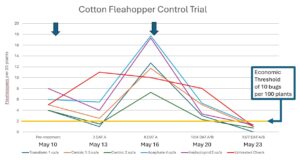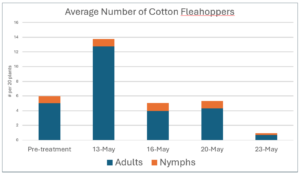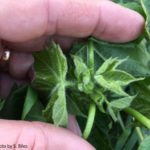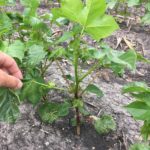 For the past few weeks many fields have been inundated with cotton fleahoppers. We began an insecticide control trial on May 10. The field averaged 5.3 cotton fleahoppers in 20 plants, well above the economic threshold of 2 fleas per 20 plants.
For the past few weeks many fields have been inundated with cotton fleahoppers. We began an insecticide control trial on May 10. The field averaged 5.3 cotton fleahoppers in 20 plants, well above the economic threshold of 2 fleas per 20 plants.
The graph below is data from the trial I have been conducting. The blue arrows indicate treatment timings. The red line is insect counts from untreated plots.  During this trial, no differences were found between treatments due to variability within treatments. Throughout the trial, 86% of the fleahoppers found were adults and 14% were nymphs.
During this trial, no differences were found between treatments due to variability within treatments. Throughout the trial, 86% of the fleahoppers found were adults and 14% were nymphs.
When looking at the data, it can appear there was little to no control of the insects. This data is misleading though. I believe we have had tremendous amounts of cotton fleahoppers developing on wild host plants and constantly migrating into the cotton fields.
The adult cotton fleahopper is a very good flyer and readily moves considerable distances. Thus, adults can easily move into recently treated cotton giving the appearance of a lack of control from the insecticide.
The telling sign will be square retention. Determine the percent square set by counting the number of squares and number of abscised or blasted (dead) squares. I have seen some fields with high % square set above 90% and others with poor square set under 60%. 
Management of cotton fleahoppers is recommended until bloom, but in some fields with lower square set, you may want to continue to treat through the first or second week of bloom. Early square loss will delay crop maturity and harvest.
The cotton plant should be blooming if it has 9 or more fruiting nodes unless the early fruit was lost to insect feeding. The first fruiting branch is usually at the 6th or 7th node above the cotlyedon leaves, which have usually fallen off the plant by now. Find where the cotyledons were by locating the two nodes directly across from each other on the lower stem.
Pinhead size and smaller squares are the most susceptible to cotton fleahopper damage. So if your field does not have as many squares as you would like, continue to treat the field if the fleahoppers are above threshold (10 fleas per 100 plants).